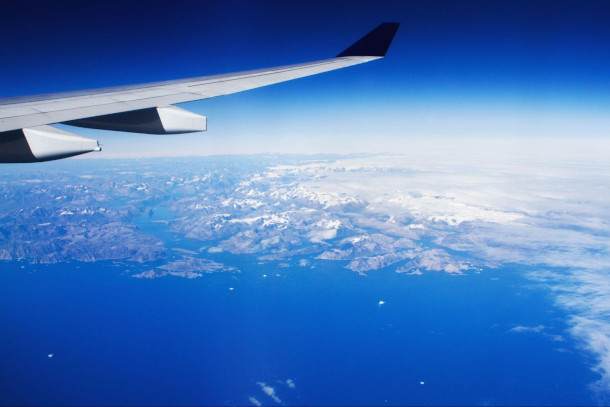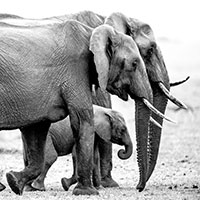Turbulence and Climate Change
Air Date: Week of May 30, 2025

Climate change intensifies storms, which can then have a knock on effect for storm-induced turbulence while flying. But researchers have also found a link between climate disruption and clear air turbulence. (Photo: Tom Blackwell, Flickr, CC BY-NC 2.0)
Emerging research predicts that with rising global temperatures, climate change may increase clear-air turbulence by as much as four times along some of the most heavily traveled routes. Clear air turbulence as the name suggests is the kind of turbulence you can’t see on most radar. It can toss around large airplanes, damage aircraft and injure passengers and crew. Reporter Bob Berwyn of Inside Climate News joins Host Jenni Doering to explain how these changes tie into the jet stream.
Transcript
BELTRAN: It’s Living on Earth, I’m Paloma Beltran.
DOERING: And I’m Jenni Doering.
The summer travel season is kicking off and for plenty of folks that means it’s time to hop on a jet plane somewhere far away. But you might be in for a bumpy ride due to increased turbulence even when the skies are clear. And yep, this is yet another example of how climate disruption is affecting just about every aspect of our lives.
Emerging research predicts that with rising global temperatures, climate change may increase clear-air turbulence by as much as four times along some of the most heavily traveled routes. Clear air turbulence as the name suggests is the kind of turbulence you can’t see on most radar. It can toss around large airplanes, damage aircraft and injure passengers and crew. Bob Berwyn has been reporting on this new research for our media partner InsideClimate News, and he’s based in Austria. Bob recently attended the big European Geosciences Union conference in Vienna where he learned about the links between turbulence and climate change. Welcome back to Living on Earth, Bob!
BERWYN: It's nice to be back again. Thanks.
DOERING: How does climate change factor into these bumpier flights?
BERWYN: So, there's been a lot of research going back, you know, a few decades on wind currents and how global warming is changing the distribution of air pressure systems and of big areas of warm air and cold air, and how they relate to each other. And it's the contrasts between these big air masses, often in the polar north and then in the mid latitudes down across North America and Europe, the contrasts that drive the winds. Some of them are called jet stream winds that flow like a wavy river all the way around the northern and southern hemispheres. And those also coincide with some of the flight routes, the flight paths of airplanes. And global warming is kind of changing the way those pressure patterns are distributed. And it gets pretty complicated, but right in an area, at an elevation and at a latitude where it can affect flights. It's increasing the turbulence. It's making the jet stream faster. And just like when a river starts to flow faster, a smooth river, if it starts to go over a little steeper slope, it goes faster, and it starts to tumble and churn. And that's kind of what's going on in these rivers of air up in the sky, too.
DOERING: So, it's like the lazy Danube River is turning into a stream in the Alps, right?
BERWYN: Right, yep.
DOERING: In your neck of the woods.
BERWYN: Exactly.
DOERING: So now, now I'm understanding just how complex this is, because we have also been hearing about the jet stream weakening in certain ways in certain parts because of climate change. And, you know, taking more dips further south, and letting that really cold arctic air come down into the East Coast, for example. So, it's doing all sorts of different things.
BERWYN: It is, exactly, yep. One of the main researchers who actually, studies the jet stream in a lot of ways, and not necessarily just related to clear air turbulence, was the one who really was able to pinpoint this particular zone of the jet stream that is affecting the amount of clear turbulence that's been happening and is projected to increase over the next few decades.
DOERING: And of course, we know that stormy weather also causes turbulence. How is clear air turbulence different?
BERWYN: It's different in that there aren't any visible signs, let's say, big thunderstorms that can go up into the altitude. Commercial passenger planes fly at their highest and, you know, sometimes planes have to fly around those clear air severe turbulence is when there are no real visible signs of it. So, you'd have to really have a detailed understanding of the way the different air masses are moving within the vertical column of the atmosphere. And that can be done, but it requires, you know, really sensitive radar instruments and looking for these anomalies, these kind of unusual patterns that would cause turbulence.
DOERING: And Bob, what did you hear from researchers about why they were interested in looking into this particular climate change impact on turbulence?
BERWYN: I had a nice interview with co-author on one of the papers, Davide Faranda, as a researcher with the French National Center for Scientific Research, said that he'd had an interest in weather and in flying since he was a little kid, and so he grew up to study meteorology, and he kept his interest in flying, and flies as part of his job, too, and was already studying this topic, and then experienced a really extreme episode of clear air turbulence on a flight across the U.S. from the West Coast to the East Coast. And described it as pretty terrifying, with objects flying through the cabin and really sort of hanging on for dear life, is what he said. And you know, he said, specifically, that it left him feeling pretty traumatized, and I think, you know, definitely is part of his motivation for working on this.

Bob Berwyn is an Austria-based reporter who covers climate science and international climate policy for Inside Climate News. (Photo: Courtesy of Bob Berwyn)
DOERING: So, Bob, we're finding out that clear air turbulence may get worse as a result of climate change. At the same time that we have air traffic control cuts and job losses at NOAA, the National Oceanic and Atmospheric Administration, and the National Weather Service. How does that complicate this problem?
BERWYN: Along with a lot of other impacts from global warming, they require more research to understand what those effects are going to be, to make more precise projections of how the atmosphere is going to be affected, because what we're talking about here goes beyond just turbulence that affects individual planes. It's really affecting a fundamental part of the climate system. It's pretty profound, if you think about it, the concentration of greenhouse gasses in the atmosphere is shifting these climate patterns that have been, you know, more or less stable for thousands and thousands of years in the time that people kind of developed and built-up modern civilization. And so, if the jet stream changes, it also changes things like where extreme weather goes, or where droughts happen, and if you undermine research and hinder the ability of scientists understand that it's going to make people everywhere more vulnerable to those types of things.
DOERING: So, before you go, what are the lessons that we should take away from this research? And what would you say to airline passengers given the bumpy rides ahead?
BERWYN: Well, I would definitely say, you know, heed the captain if he says to keep your seatbelt buckled. My takeaway is the profound effect that we're causing on the whole climate system through our emission of greenhouse gasses that we're changing these incredibly complex and tuned up climate mechanisms that affect, you know, weather patterns across the globe, and that's shifting and changing fast. And you know, we need to understand what's going on more than ever, and the air turbulence is one of the symptoms that catches a lot of people's attention.
DOERING: Bob Berwyn is a reporter with our media partner InsideClimate News, and he's based a very long flight away in Austria. Thanks, Bob.
BERWYN: You're welcome.
Links
Living on Earth wants to hear from you!
Living on Earth
62 Calef Highway, Suite 212
Lee, NH 03861
Telephone: 617-287-4121
E-mail: comments@loe.org
Newsletter [Click here]
Donate to Living on Earth!
Living on Earth is an independent media program and relies entirely on contributions from listeners and institutions supporting public service. Please donate now to preserve an independent environmental voice.
NewsletterLiving on Earth offers a weekly delivery of the show's rundown to your mailbox. Sign up for our newsletter today!
 Sailors For The Sea: Be the change you want to sea.
Sailors For The Sea: Be the change you want to sea.
 The Grantham Foundation for the Protection of the Environment: Committed to protecting and improving the health of the global environment.
The Grantham Foundation for the Protection of the Environment: Committed to protecting and improving the health of the global environment.
 Contribute to Living on Earth and receive, as our gift to you, an archival print of one of Mark Seth Lender's extraordinary wildlife photographs. Follow the link to see Mark's current collection of photographs.
Contribute to Living on Earth and receive, as our gift to you, an archival print of one of Mark Seth Lender's extraordinary wildlife photographs. Follow the link to see Mark's current collection of photographs.
 Buy a signed copy of Mark Seth Lender's book Smeagull the Seagull & support Living on Earth
Buy a signed copy of Mark Seth Lender's book Smeagull the Seagull & support Living on Earth

